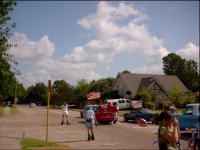Lawn & Garden - Fertilization Schedule
For southern grasses including: St. Augustine, Bermuda and Zoysia
- FERTILIZE - four times a year:
Late February-Early March - apply a simple 15-5-10 for an early green-up. Most companies that make slow-release fertilizers also make a non slow-release 15-5-10 that provides for a quick two-week green up before we get to the heart of the fertilizer schedule.
WARNING: Some people will be tempted to use a weed-and-feed at this time, but if you've been following the GardenLine herbicide schedule, there should never be a need. However, spot weed-and-feed treatments are recommended for those with turf-only landscapes or landscapes that have been established for many years. Most weed-and-feeds contain Atrizine which burns roots of young trees and shrubs.
Late March-Early April - apply slow-release 3-1-2 ratio fertilizers.
Recommended formulations:19-4-10 Nitro Phos Super Turff 18-4-6 Fertilome Southwest Greenmaker 18-0-6 Fertilome's Zero Phosphate Formula 15-5-10 Southwest Fertilizer Premium Gold 20-0-10 Bonide Premium Lawn Food
Late June-Early July - apply slow-release 3-1-2 ratio fertilizers.
(recommended formulations 19-5-9, 19-4-10, 18-4-6, 15-5-10.)
October-November - apply winterizer formulas for winter hardiness. Ratios vary, but make sure they are "winter" or "fall" formulas designed for southern grasses.
(examples: 18-6-12, 8-12-16, 10-5-14) Will make lawns winter-hardy.
June-September - if turfgrass looks yellow (chlorosis) or necrotic, use an application of either granular or liquid iron. Once a year should be enough.
- FUNGICIDE - two times a year:
July-September - Gray Leaf Spot is a blotchy spot on the grass blade leafs. (mostly on St. Augustine lawns) Use fungicides with active ingredients like Daconil, Consan or Banner.
September-October - To control the dreaded Brownpatch fungal disease (symmetrical brown circles in the grass) you must prevent it from coming up with a systemic lawn fungicide with Bayleton, Terrachlor, Banner or Benomyl.
- HERBICIDE - three times a year:
(Pre-Emergent controls to prevent weeds)
Late October-Early November - Use two (2) different pre-emergent herbicides, to prevent the weeds that we experience in February and March. First is a pre-emergent with Portrait or Gallery for broadleaf weeds like clover. Second, use a pre-emergent with Amaze, Betasan, Balan or Treflan for grassy weeds like poa anna or annual bluegrass. There is also Barricade, Dimension or Pendimethlin as a 2-in-1 control.
February-March - Use the pre-emergent controls for grassy weeds again, to prevent such weeds as Crabgrass, Goosegrass and Dallisgrass from popping up late in the spring and summer. Again, use the grassy pre-emergent like Amaze, Betasan, Balan or Treflan. There is also Barricade, Dimension or Pendimethlin as a 2-in-1 control.
May-Early June - One more application of a grassy pre-emergent like Amaze, Betasan, Balan, or Treflan will keep fall weeds from invading from August on. There is also Barricade, Dimension-based or Pendimethlin as a 2-in-1 control.
- INSECTICIDES — It is our belief on GardenLine, as a way to be kind to the environment, that you do not put down insecticides unless you know you have a problem. However, be prepared during the hot summer months — July through September — to attack chinch bug damage. This will show up as irregular shaped spots in the lawn along the concrete. Any liquid insecticide, like Permethrin or Cypermethrin, will treat the spot well. Then apply a granular insecticide like Deltamethrin or granular Permethrin in a broadcast applicator throughout the rest of the yard.
CLICK HERE for a one-page fertilization schedule
you can keep on your refrigerator.
This information is provided by Randy Lemmon
and the GardenLine program on 740 KTRH
www.randylemmon.com

